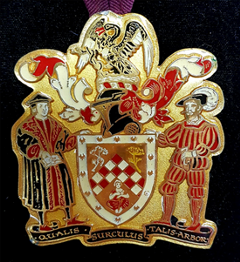Description and meaning of the Coat of Arms

The central shield is divided by a chevron. The red and white checks indicate the colours of the surgeons’ bandages. In the lower area is a mother breastfeeding an infant, indicating the unity of mother and child in paediatrics and shared responsibility with the obstetrician. In the upper area are two herbs, fennel and dill, of great antiquity in paediatric medicine. The shield has a border of ermine, as in the arms of Australia, to indicate the College as a federal body and the states bound together in unity.
Above this is a 'helm close', as granted to corporate bodies, and above this again the crest shows a black swan standing on its nest, defending its young, holding a gold staff of Asclepios keeping illness at bay. The swan is a national bird, found in every state and one of the supporters of the arms of the City of Canberra, where most early College meetings were held. Around the swan’s neck is a silver seven-pointed star as in the Australian flag, a point for each state.
The supporters represent the earliest authors of paediatric works. Thomas Phaer (also Phayer, Phair), MP, scholar and physician (circa 1535) wrote The Boke of Chyldren, the first paediatric text in English. Felix Wurtz was the second of three generations of surgeons of the same name and wrote Der Practice Wund-Artzney, the first text on paediatric surgery, as an appendix to a German edition of Hortus Sanitatis (circa 1550). Each is dressed in the robes appropriate to his profession, time and place – Thomas holds a copy of his book and Felix a fleam (a medieval form of surgeon’s scalpel).
The motto 'Qualis Surculus Talis Arbor' was created for this coat of arms, with the original idea being 'as the twig is bent the tree will grow', suggesting genetics, nutrition, obstetric care, orthopaedics etc. This was clumsy in direct Latin translation – after careful consideration it was suggested the motto should be officially translated as follows: 'As is the twig, so is the tree.'